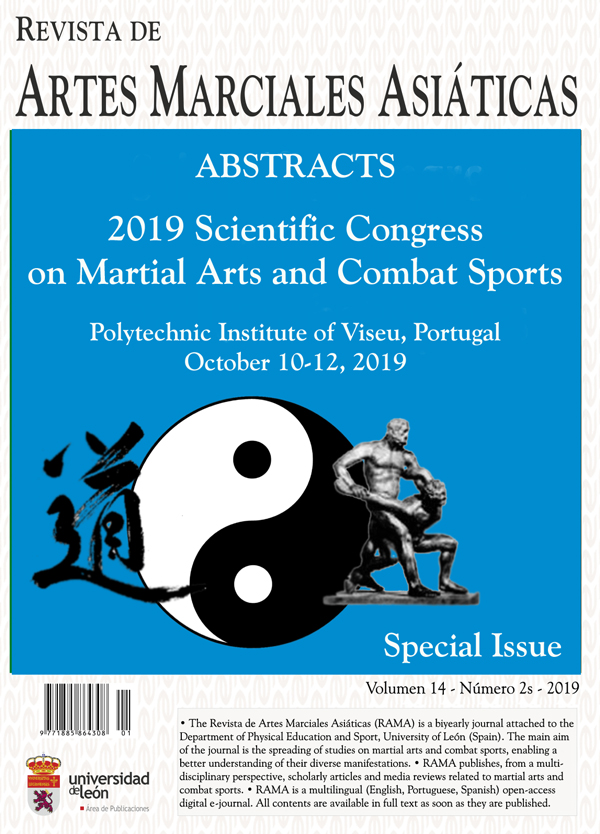Old Polish warrior's path - psychophysical and martial preparation of a young nobleman in modern Poland
DOI:
https://doi.org/10.18002/rama.v14i2s.5965Keywords:
Martial arts, Polish martial arts, Polish sabre fencing, palcaty, training methodology, short stick fightingAgencies:
Idokan Poland Association in Rzeszów (Poland)Abstract
The article attempts to outline the path a young nobleman underwent in the 16-17th century Poland in order to achieve prowess in battle martial arts. It presents patterns and ways of training the nobleman was subjected to from an early age, the process of a future warrior’s mental and physical preparation. Furthermore, it describes various types of body exercises and trainings with many weapon types. A fundamental novelty is presentation of the training methodology. Its over four centuries of age notwithstanding it has basically been valid until nowadays and encompasses such features as diet or exercise intensity. Eventually this article presents the individual stages of said training, closely related to warrior’s age and psychophysical development. Material for the study was obtained thanks to the textual analysis, both from the era (16 to 17th century sources) and from the limited literature on the topics (monographs, magazine articles, periodicals, the Internet) addressing the subject. The result depicts arduous, however consistent and sensible old Polish training system. After many years of wisely carried out exercises an effective, skilled warrior was produced, furnished with high fighting skills and morale, ready to fight his country enemies. At the same time whilst getting old such a warrior could train the next generations of Homeland’s knights-defenders. The objective of the article is to draw attention to the subject of Polish warriors, their training and martial arts, hitherto unmentioned in English literature and to encourage further research in this field.
Downloads
Métricas alternativas
References
Borysiuk, Z. (2005). Historyczne przeobrażenie szabli jako broni siecznej. Ido – Ruch dla Kultury / Movement for Culture, 5, 9-15.
Brzeziński, R. (1987). The Polish Armies 1569-1696 (vol 1). London: Bloomsury Publishing.
Cynarski, W. J. (2012). A Christian and the martial arts path. Ido Movement for Culture. Journal of Martial Arts Anthropology, 16(2), 1-7. doi: http://doi.org/10.14589/ido.16.2.1
Cynarski, W. J. (2019). Martial Arts & Combat Sports: Towards the General Theory of Fighting Arts. Gdańsk: Wydawnictwo Naukowe Katedra.
Cynarski, W. J., & Litwiniuk, A. (2000). Metody przygotowani psychicznego w sztukach walki. Ido-Ruch dla Kultury / Movement for Culture, 1, 121-124.
Czajkowski, Z. (2007). Szermierka w dawnej Polsce. Ido – Ruch dla Kultury / Movement for Culture, 7, 55-64.
Górnicki, Ł. (1566). Dworzanin polski. Warszawa: Maciej Wirzbięta.
Łaski, S. (1599). Spraw i postępków rycerskich i przewagi opisanie krótkie. Lwów: M. Bernat.
Maroteaux, R. J. (2011). Special sabre polonais & japonais. Aiki Goshin Do Kaishi, (55), 12-22. Avignon.
Maroteaux, R. J. (2019). Special sabre polonais. Aiki Goshin Do Kaishi, (77), 23-27.
Marsden, R. (2015). The polish saber. Cambridge: Tyrant Industries.
Paprocki, B. (1584). Herby rycerstwa polskiego. Kraków: Maciej Garwolczyk.
Petrycy, S. (1605). Polityki Arystelesowej to jest rządu rzeczypospolitej z dokładem ksiąg ośmioro, część wtóra. Kraków: S. Kempini.
Pokojski, K. (2019). Sarmaci najczystszym narodem chrześcijańskiej Europy – brud w XVI-XVII wiecznej Europie. Retrieved from http://www.kresy.pl/kresopedia,historia,rzeczpospolita?zobacz%2Fsarmaci-najczystszym-narodem-chrzescijanskiej-europy-brud-w-xvi-xvii-wiecznej-europie
Pokojski, K. (2019). Szkolenie rycerskie jako istotny element wychowania młodego szlachcica w XVI-XVIII wieku. Retrieved from http://szablaipiorem.pl/szkolenie-rycerskie-jako-istotny-element-wychowania-modego-szlachcica-w-xvi-xvii-wieku
Pokojski, K. (2015). Tczew 1627. Warszawa: Erica.
Rej, M. (1567). Zwyerciadło albo kstałt w którym każdy stan snadnie się może swym sprawom iako we źwierciadle przypatrzyć. Kraków: M. Wirzbięta.
Sawicki, Z. (2014). Influence of the Polish martial art onto European armies in the 18th and 19th centuries. Ido Movement for Culture. Journal of Martial Arts Anthtopology, 14(4), 3-13. doi: https://doi.org/10.14589/ido.14.4.2
Sawicki, Z. (2008). Michała Starzewskiego traktat „O szermierstwie” w interpretacji Zbigniewa Sawickiego. Zawiercie: Wydawnictwo Signum Polonicum.
Sawicki, Z. (2005). Palcaty. Podręcznik dla początkujących. Zawiercie: Wydawnictwo Signum Polonicum.
Sawicki, Z. (2019). Palcaty Staropolska szermierka na kije (Studium historyczne z dziejów kultury fizycznej). Author’s collection materials from doctoral dissertation.
Sawicki, Z. (2011). PolishMartialArts – Signum Polonicum: Historical background and the main plots of the system. Ido Movement for Culture. Journal of Martial Arts Anthtopology, 11(2), 38-46.
Sawicki, Z. (2012). Traktat szermierczy o sztuce walki polską szablą husarską część druga. Zawiercie: Wydawnictwo Napoleon V.
Sawicki, Z. (2004). Traktat szermierczy o sztuce walki szabla husarską. Podstawy. Zawiercie: Wydawnictwo Signum Polonicum.
Starowolski, Sz. (1631). Sarmatiae Bellatores, Koln: H. Kritius.
Testament Stanisława Żółkiewskiego. (1606). In A. Krasiński (Ed.). (1845). Biblioteka warszawska (Vol. 2, pp. 303-311). Warszawa: W Drunkarni Stanislawa Strabskiege.
Downloads
Published
How to Cite
Issue
Section
License
Copyright (c) 2019 Jakub Pokojski

This work is licensed under a Creative Commons Attribution-NonCommercial-ShareAlike 4.0 International License.
The authors who publish in this journal must agree to the following terms:
- The authors grant on a nonexclusive basis the exploitation rights (reproduction, distribution, public communication and transformation) of the work accepted for publication to the University of León. The authors can establish, on their own, additional agreements for the non-exclusive distribution of the version of the work published in the journal (for example, placing it in an institutional repository or publishing it in a book), always acknowledging the initial publication in this journal.
- This work is licensed under the Creative Commons Attribution-NonCommercial-ShareAlike 4.0 International License. Click to see basic information and the legal text of the license.
- The authors are allowed and encouraged to disseminate electronically pre-print or post-print versions of their work before publication, as this can give rise to productive exchanges, as well as earlier and increased citing of the works published.











